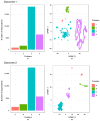Characterizing Healthy Dietary Practices in Japan: Insights from a 2024 Nationwide Survey and Cluster Analysis
- PMID: 38794650
- PMCID: PMC11124242
- DOI: 10.3390/nu16101412
Characterizing Healthy Dietary Practices in Japan: Insights from a 2024 Nationwide Survey and Cluster Analysis
Abstract
The increasing burden of lifestyle-related diseases highlights the need to address unhealthy dietary habits. This study aims to explore the latest dietary patterns in Japan following the COVID-19 pandemic, focusing on trends in health-promoting food choices. A web-based survey was conducted among 27,154 Japanese adults, selected via quota sampling to mirror national demographics. The study evaluated dietary diversity, measured through the Dietary Variety Score (Outcome 1), and the prioritization of nutritional and health considerations in food selection, assessed via a Likert scale (Outcome 2). Uniform Manifold Approximation and Projection (UMAP) and Ordering Points To Identify the Clustering Structure (OPTICS) algorithms were used to delineate patterns in health-centric food selections. OPTICS clustering revealed four distinct clusters for each outcome. Cluster 3, with a diverse diet, comprised older, predominantly female individuals with higher well-being and lower social isolation compared to Cluster 4, which lacked distinct dietary patterns. Cluster 3 also engaged more in snacking, treat foods, home cooking, and frozen meals. Similarly, a divide emerged between those prioritizing dietary considerations (Cluster C) and those indifferent to such aspects (Cluster D). The findings underscore the need for holistic post-COVID-19 public health initiatives addressing socioeconomic and cultural barriers to healthier dietary practices.
Keywords: Japan; clustering; dietary diversity; dietary habits.
Conflict of interest statement
The authors declare no conflicts of interest.
Figures

Similar articles
-
Did social isolation during the SARS-CoV-2 epidemic have an impact on the lifestyles of citizens?Epidemiol Prev. 2020 Sep-Dec;44(5-6 Suppl 2):353-362. doi: 10.19191/EP20.5-6.S2.137. Epidemiol Prev. 2020. PMID: 33412829 English.
-
Dietary Behaviors in the Post-Lockdown Period and Its Effects on Dietary Diversity: The Second Stage of a Nutrition Survey in a Longitudinal Chinese Study in the COVID-19 Era.Nutrients. 2020 Oct 26;12(11):3269. doi: 10.3390/nu12113269. Nutrients. 2020. PMID: 33114499 Free PMC article.
-
Factors Associated with Dietary Change since the Outbreak of COVID-19 in Japan.Nutrients. 2021 Jun 14;13(6):2039. doi: 10.3390/nu13062039. Nutrients. 2021. PMID: 34198633 Free PMC article.
-
Dietary Disruptors in Romania: Seasonality, Traditions, and the COVID-19 Pandemic.Nutrients. 2025 Jan 3;17(1):183. doi: 10.3390/nu17010183. Nutrients. 2025. PMID: 39796617 Free PMC article.
-
Cooking Frequency and Perception of Diet among US Adults Are Associated with US Healthy and Healthy Mediterranean-Style Dietary Related Classes: A Latent Class Profile Analysis.Nutrients. 2020 Oct 25;12(11):3268. doi: 10.3390/nu12113268. Nutrients. 2020. PMID: 33113837 Free PMC article.
References
-
- COVID-19 National Preparedness Collaborators Pandemic preparedness and COVID-19: An exploratory analysis of infection and fatality rates, and contextual factors associated with preparedness in 177 countries, from 1 January 2020, to 30 September 2021. Lancet. 2022;399:1489–1512. doi: 10.1016/S0140-6736(22)00172-6. - DOI - PMC - PubMed
MeSH terms
Grants and funding
LinkOut - more resources
Full Text Sources
Medical

